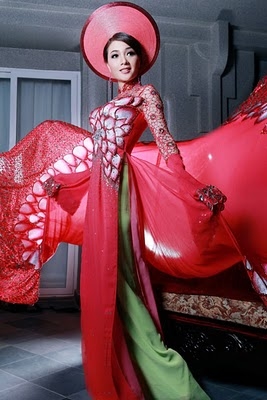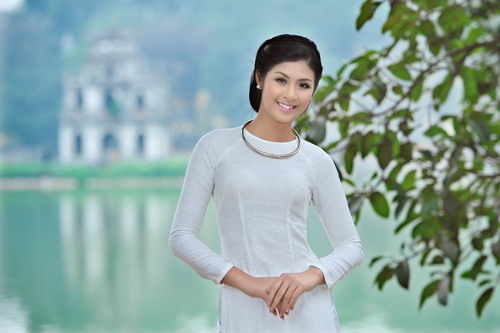Ao dai Vietnam (Vietnamese long dress) is considered to be an elegant, yet demure, garment. Over time, the Ao Dai style has evolved, keeping with fashion trends.
Early versions of ao dai style comprised of 4 to 5 panels of silky, flowing fabric, layered over loose-fitting trousers of the same material. The number of layers usually signified the wealth of the person wearing it – the more panels or layers, the more wealth. Some of the very wealthy would even wear more than one ao dai at the same time.
Historically, Vietnamese men dressed in mandarin style suits. With a tunic shorter and fuller than the ao dai ( long dress), the suit’s color was traditionally determined by the man’s class and social rank. Traditionally, long, wide- legged trousers are worn under a high-necked, long-sleeved, fitted tunic with slits along each side. The outfit’s pants reach to the soles of the feet, often trailing along the ground.For example, a purple suit denoted a high rank while blue denoted a low rank. Status was also indicated through a variety of embroidered symbols. Today the mandarin suit is rarely worn except for in traditional dance or music performances.
Over time, the dress tunic has evolved, keeping with fashion trends, and has grown shorter and shorter until it now falls just below the knees. Presently, most ao dai styles consist of only two pieces – a dress worn over loose silk pants, the dress varying in length from just below the knee to the ground. The ao dai (long dress) consists of two to four panels, has a well-fitted bodice and is split on the sides from the waist down.
Early style versions had buttons up the front or side, but in recent years, the seams run diagonally from the neckline to the underarm and seem to be the preferred style.The ao dai style can also be identified by its mandarin-style or boat-neck collar. Young girls wear only pastel colored or white garments while married women wear either dark or bright tunics over black or white trousers.
Recently, however, it has made a comeback and is regaining popularity in the south among schoolgirls and office workers, and is being worn at formal functions. An indication of social standing, the ao dai is worn by women who work as shop assistants or who have a higher social status, while manual workers typically wear a loose top and baggy pants called an ao ba ba.
In general, Vietnamese people dress conservatively. Although some young women wear more close-fitting, Western-style clothing, it is considered inappropriate to wear revealing clothes during the day. One Westerner teaching English in Viet Nam was advised to tuck her shirt into her trousers if she expected respect from her students. It is considered inappropriate for educated people to wear their shirts untucked.
Source : *Ao dai styles
*
Read more : http://vietnamcharm.com/tag/ao-dai-vietnam




